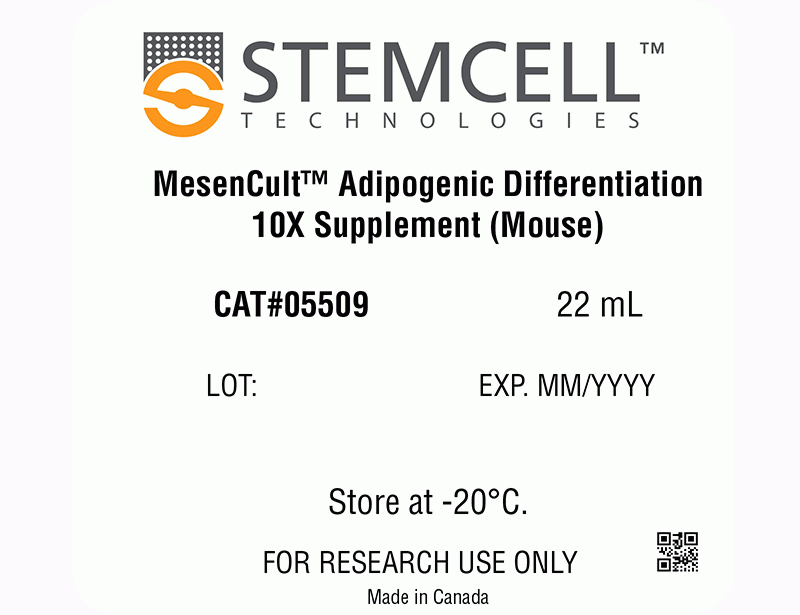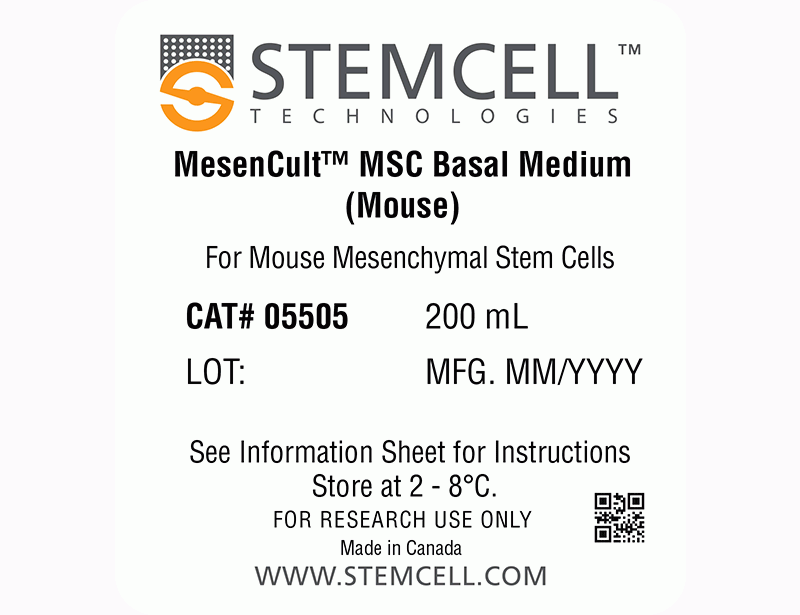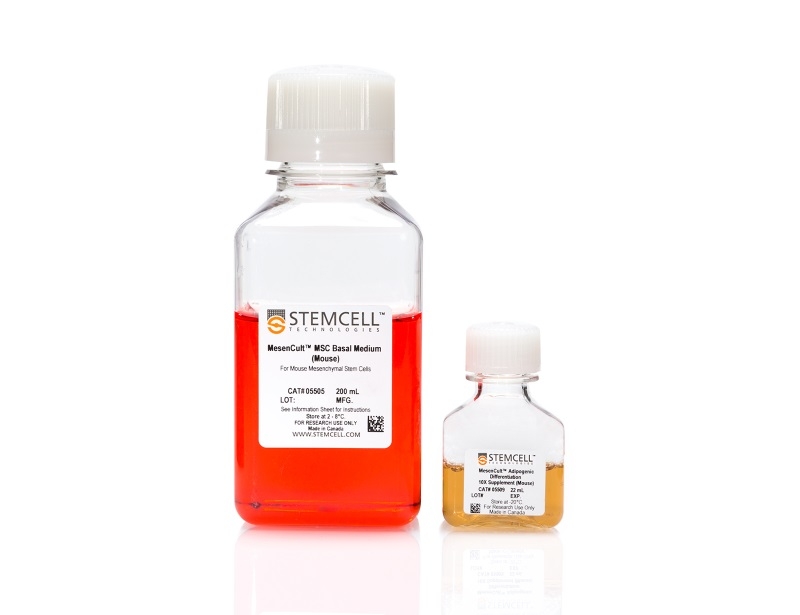概要
MesenCult™ Adipogenic Differentiation Kit (Mouse) is specifically formulated for the in vitro differentiation of mouse mesenchymal stem and progenitor cells (MSCs), adipose tissue-derived MSCs (ADSCs), and mouse embryonic fibroblasts (MEFs) into cells of the adipogenic lineage.
NOTE: MesenCult™ Adipogenic Differentiation Medium must be supplemented with L-Glutamine (Catalog #07100).
NOTE: MesenCult™ Adipogenic Differentiation Medium must be supplemented with L-Glutamine (Catalog #07100).
技术资料
| Document Type | 产品名称 | Catalog # | Lot # | 语言 |
|---|---|---|---|---|
| Product Information Sheet | MesenCult™ Adipogenic Differentiation Kit (Mouse) | 05507 | All | English |
| Safety Data Sheet 1 | MesenCult™ Adipogenic Differentiation Kit (Mouse) | 05507 | All | English |
| Safety Data Sheet 2 | MesenCult™ Adipogenic Differentiation Kit (Mouse) | 05507 | All | English |
数据及文献
Publications (5)
Biology open 2020 jun
Site-1 protease ablation in the osterix-lineage in mice results in bone marrow neutrophilia and hematopoietic stem cell alterations.
Abstract
Abstract
Site-1 protease (S1P) ablation in the osterix-lineage in mice drastically reduces bone development and downregulates bone marrow-derived skeletal stem cells. Here we show that these mice also suffer from spina bifida occulta with a characteristic lack of bone fusion in the posterior neural arches. Molecular analysis of bone marrow-derived non-red blood cell cells, via single-cell RNA-Seq and protein mass spectrometry, demonstrate that these mice have a much-altered bone marrow with a significant increase in neutrophils and Ly6C-expressing leukocytes. The molecular composition of bone marrow neutrophils is also different as they express more and additional members of the stefin A (Stfa) family of proteins. In vitro, recombinant Stfa1 and Stfa2 proteins have the ability to drastically inhibit osteogenic differentiation of bone marrow stromal cells, with no effect on adipogenic differentiation. FACS analysis of hematopoietic stem cells show that despite a decrease in hematopoietic stem cells, S1P ablation results in an increased production of granulocyte-macrophage progenitors, the precursors to neutrophils. These observations indicate that S1P has a role in the lineage specification of hematopoietic stem cells and/or their progenitors for development of a normal hematopoietic niche. Our study designates a fundamental requirement of S1P for maintaining a balanced regenerative capacity of the bone marrow niche.
Bioactive materials 2020 dec
3D-printable supramolecular hydrogels with shear-thinning property: fabricating strength tunable bioink via dual crosslinking.
Abstract
Abstract
3-dimensional (3D) bioprinting technology provides promising strategy in the fabrication of artificial tissues and organs. As the fundamental element in bioprinting process, preparation of bioink with ideal mechanical properties without sacrifice of biocompatibility is a great challenge. In this study, a supramolecular hydrogel-based bioink is prepared by polyethylene glycol (PEG) grafted chitosan, $\alpha$-cyclodextrin ($\alpha$-CD) and gelatin. It has a primary crosslinking structure through the aggregation of the pseudo-polyrotaxane-like side chains, which are formed from the host-guest interactions between $\alpha$-CD and PEG side chain. Apparent viscosity measurement shows the shear-shinning property of this bioink, which might be due to the reversibility of the physical crosslinking. Moreover, with $\beta$-glycerophosphate at different concentrations as the secondary crosslinking agent, the printed constructs demonstrate different Young's modulus (p {\textless} 0.001). They could also maintain the Young's modulus in cell culture condition for at least 21 days (p {\textless} 0.05). By co-culturing each component with fibroblasts, CCK-8 assay demonstrate cellular viability is higher than 80{\%}. After bioprinting and culturing, immunofluorescence staining with quantification indicate the expression of Ki-67, Paxillin, and N-cadherin is higher in day 14 than those in day 3 (p {\textless} 0.05). Oil red O and Nissl body specific staining reflect strength tunable bioink may have impact on the cell fate of mesenchymal stem cells (p {\textless} 0.05). This work might provide new idea for advanced bioink in the application of re-establishing complicated tissues and organs.
Scientific reports 2019 nov
Machine Learning to Quantitate Neutrophil NETosis.
Abstract
Abstract
We introduce machine learning (ML) to perform classification and quantitation of images of nuclei from human blood neutrophils. Here we assessed the use of convolutional neural networks (CNNs) using free, open source software to accurately quantitate neutrophil NETosis, a recently discovered process involved in multiple human diseases. CNNs achieved {\textgreater}94{\%} in performance accuracy in differentiating NETotic from non-NETotic cells and vastly facilitated dose-response analysis and screening of the NETotic response in neutrophils from patients. Using only features learned from nuclear morphology, CNNs can distinguish between NETosis and necrosis and between distinct NETosis signaling pathways, making them a precise tool for NETosis detection. Furthermore, by using CNNs and tools to determine object dispersion, we uncovered differences in NETotic nuclei clustering between major NETosis pathways that is useful in understanding NETosis signaling events. Our study also shows that neutrophils from patients with sickle cell disease were unresponsive to one of two major NETosis pathways. Thus, we demonstrate the design, performance, and implementation of ML tools for rapid quantitative and qualitative cell analysis in basic science.
Journal of biomedical materials research. Part A 2019 jul
Aligned fibrous decellularized cell derived matrices for mesenchymal stem cell amplification.
Abstract
Abstract
Biochemical and biophysical stimuli of stem cell niches finely regulate the self-renewal/differentiation equilibrium. Replicating this in vitro is technically challenging, making the control of stem cell functions difficult. Cell derived matrices capture certain aspect of niches that influence fate decisions. Here, aligned fibrous matrices synthesized by MC3T3 cells were produced and the role of matrix orientation and stiffness on the maintenance of stem cell characteristics and adipo- or osteo-genic differentiation of murine mesenchymal stem cells (mMSCs) was investigated. Decellularized matrices promoted mMSC proliferation. Fibrillar alignment and matrix stiffness work in concert in defining cell fate. Soft matrices preserve stemness, whereas stiff ones, in presence of biochemical supplements, promptly induce differentiation. Matrix alignment impacts the homogeneity of the cell population, that is, soft aligned matrices ameliorate the spontaneous adipogenic differentiation, whereas stiff aligned matrices reduce cross-differentiation. We infer that mechanical signaling is a dominant factor in mMSC fate decision and the matrix alignment contributes to produce a more homogeneous environment, which results in a uniform response of cells to biophysical environment. Matrix thus produced can be obtained in vitro in a facile and consistent manner and can be used for homogeneous stem cell amplification or for mechanotransduction-related studies.
Nature communications 2019
IL-33-mediated mast cell activation promotes gastric cancer through macrophage mobilization.
Abstract
Abstract
The contribution of mast cells in the microenvironment of solid malignancies remains controversial. Here we functionally assess the impact of tumor-adjacent, submucosal mast cell accumulation in murine and human intestinal-type gastric cancer. We find that genetic ablation or therapeutic inactivation of mast cells suppresses accumulation of tumor-associated macrophages, reduces tumor cell proliferation and angiogenesis, and diminishes tumor burden. Mast cells are activated by interleukin (IL)-33, an alarmin produced by the tumor epithelium in response to the inflammatory cytokine IL-11, which is required for the growth of gastric cancers in mice. Accordingly, ablation of the cognate IL-33 receptor St2 limits tumor growth, and reduces mast cell-dependent production and release of the macrophage-attracting factors Csf2, Ccl3, and Il6. Conversely, genetic or therapeutic macrophage depletion reduces tumor burden without affecting mast cell abundance. Therefore, tumor-derived IL-33 sustains a mast cell and macrophage-dependent signaling cascade that is amenable for the treatment of gastric cancer.

 网站首页
网站首页




